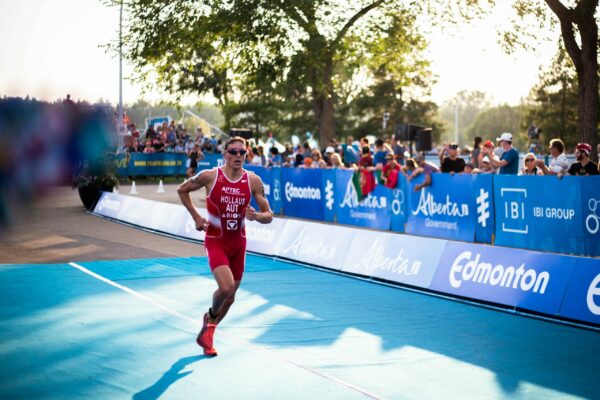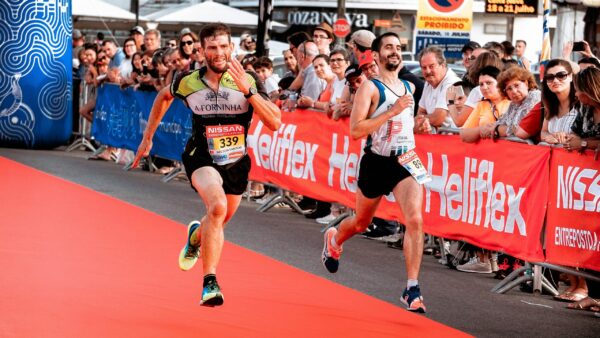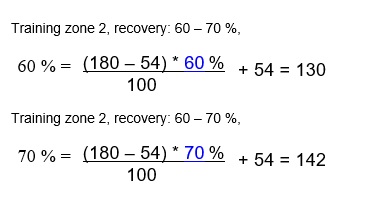There are two ways to manage running intensity. The Borg scale or the HRM. How to use training zones in marathon training is about Heart rate monitoring (HRM) – the fundamentals. There are a few fundamental concepts in training with HRM. A heart rate training zone is a range that defines the upper and lower limits of training intensities. So, what is a training zone – in marathon training…
The base is working heart rate (WHR), resting heart rate (RHR), maximal heart rate (MHR) and 5 training zones.

Target Heart Rate Calculation & Training Zones
When you perform marathon training, you work with various training intensities. Training at the correct intensity helps you get the most out of your training sessions and making sure you’re not pushing too hard or too little.
By using training zones, you can divide and target training intensities in various intervals depending on the specific purpose of your training sessions. Below we look at what exercise intensity means, training zones, and how to maximize your training.
Working Heart Rate (WHR)
The HR measured during running can also be used to show, whether you are in better shape, since the HR at a given speed, will decrease as you get in better shape. WHR is a given running intensity e.g. if you run 3 km with a heart rate of 126 beats/min.
Using WHR as a tool to assess training efficiency and intensity is simple and workable in practice. However, the WHR only provides useful information, when you know your maximum achievable heart rate MHR.
The MHR will not be higher by an improved training state. MHR will on the contrary decrease gradually with age around 1-1.2 Heartbeats/min. for each year after you have passed the age of 25 years. However, this is not an expression of the Oxygen uptake or the performance decreases.
The two extremities in your heartbeats are RHR and MHR.
Resting Heart Rate (RHR)
RHR is the Resting Heart Rate, which is your HR when you are completely at rest. Your resting heart rate may vary slightly according to how much you have slept your comfort etc. Therefore, the best way to find your resting heart rate is to measure it three days in a row and calculate the average of these measurements.
It is best to measure your HR, just when you wake up in the morning before you get up. You can use your HRM to measure it, or you can measure it by counting the HR on your wrist or neck.
Count the HR in 30 seconds and multiply with 2, then you have your resting heart rate as the number of beats per. Minute.
Since your resting heart rate will decrease, as you get in better shape, therefore you should periodically like every month, measure your resting heart rate.
Maximum Heart Rate (MHR)
Your maximum heart rate is the highest intensity you can reach. It is hard to find the max. HR in practice, but you only need to do it once, If you have a little experience as a runner or from another sport, and the courage to find your true MHR in practice, you can do it as follows:
Warm-up thoroughly with stretch exercises and easy running in 15-20 minutes, and then run 600 – 800 meters as fast as you can, push yourself to maximum on the last 100 meters, and read off or measure your heart rate immediately after the race.
Immediately has to be taken quite literally, since your heart rate very quickly, will begin to fall again. The intention is that you run your absolute maximum.
The Maximum heart rate is primarily genetically determined and you will not see any change, even if you get in much better shape.
If you are not ready to find your maximum heart rate by the “natural” method, you can use the rule of thumb which says, your maximum heart rate MHR = 220 minus your age as a man, and 226 minus your age as a woman.

Calculate your work intensity (WHR)
With the MHR, you can calculate the work intensity, expressed as a percentage of MHR at a given working heart rate WHR. Let us take a 40-year-old man as an example:
His maximum heart rate MHR is
220 – 40 = 180 beats/min., he runs with a WHR on 126 beats/min.
This would correspond to a work intensity of 70 % because:
WHR*100/MHR = Work intensity (WI)
We get: 126 beats/min. * 100 / 180 beats/min. = 70 %.
A more accurate calculation
If you are beginner, this is an excellent method. However, it is a highly uncertain method if you are more experienced. If you want a more accurate calculation, you must involve the resting heart rate RHR in the calculation. Assume that the 40-year old man has an RHR in the morning at 54 beats/ min.
When we subtract RHR from MHR (180-54) we get 126. This numerical value describes the heart rate reserve HRR or the interval, within which the heart rate may vary. If the 40-year old runner again has to run with an intensity of 70 % of MHR, the calculation looks like this:
(MHR – RHR) * WI / 100 + RHR = WHR.
We get: (180 – 54) * 70 / 100 + 54 = 142 beats/min.
By training with an intensity of 70 %, the WHR has to be 142 in this case.
If you in this way calculate the WHR with the RHR included, then the
WHR in our example at 70 % intensity becomes 16 beats/min. higher
(142 – 126). This difference is important and closer to the right or true WI. Besides if our man had found his true MHR in practice to 190 beats/ min., then the WHR would be 149 and the entire 23 beats/min. higher.
Why do we include the RHR in the calculation?
The reason why the RHR must be included in the calculation is that your heart rate is never zero. To take 70 % of your MHR would therefore be misleading because the bottom about 50 % solely is for the maintenance of your existence.
Therefore, we subtract the RHR from the MHR, before we calculate the percentages, and then add RHR back again at last, so it does not affect the outcome. What you get out of it, is your WHR.
Training Zones In Marathon Training

Now when you know the basics in HR training, you can begin to organize the training after which intensity, you want to run. The interval between RHR and the MHR is called Heart rate reserve (HHR) and it is within this range, the training intensity determines.
RHR is an expression of a training intensity of 0 % while the MHR is a measure for 100 percent training intensity. We can arrange the training intensity in 5 different training zones.
Which or what zones you want to use depends partly on your current training level, and partly on your goal distance in the future. The difference in training conditions for the beginner/intermediate runner and the experienced runner is about 10 % when determining training zones.
Let us look at the 5 training zones below:
Training zone 1 (Recovery run)

In this first training zone, the intensity is at 50 – 60 percent of heart rate reserve (HRR). The activity here is very easy and will have almost no enhancing effect on your shape, the aerobic endurance.
However, this pace is suited as recovery run (active recovery), where the body needs rest and time for rebuilding. The purpose of running in this zone is also to warm up the body before the real training and cool down when you have finished the training.
The load on muscles and joints is minimal. Beginners with no significant experience in running or other runners, which after an injury or longer break, want to start up with gentle running, should accomplish a large part of the training in this zone.
Training zone 2 (Fat combustion)

If the intensity increases to about 60 – 70 percent of the HRR, the activity will still be easy. At this intensity, there will be a good shape-enhancing effect, especially for beginners. This is the training zone for marathon beginners/intermediate.
The intensity will suit so, you can have a conversation with a training partner. There will still be much oxygen available for the muscles and therefore between 30 and 50 percent of the energy continues to come from fat combustion.
Training zone 3 (Marathon training)

The third training zone is the training intensity at 70 to 80 percent of the HRR this is the marathon-training zone (LSD zone). The vast majority of experienced marathon runners train their long runs in this zone where the balance between intensity and HR is optimal.
This training zone is your aerobic capacity’s main building block, and you gain an improved ability for long-distance running. The intensity means that the training becomes a bit hard.
The energy comes mainly from fat combustion and your body gets used to using fat rather than carbohydrates.
You will be better and better to combust fat that not automatically, will be stored in the fat depots but decomposes and sent into the blood as fatty acids, which uses by the working muscles. Fat combustion is more Oxygen demanding than carbohydrate combustion but as your Oxygen uptake increases, this will be a minor problem.
Since carbohydrates are a precious and limited source of energy for the long-distance runner, it applies to both the beginner and the top runner to improve the oxygen uptake most possible, so that the body grows accustomed to saving on carbohydrates.
It is not yet a competitive pace, but it is tiring to talk together. For the beginner, the lactate threshold (LT) is located within this training zone.
Training zone 4 (competition training)

Here is the intensity between 80 to 90 % of the HRR. It is in this zone that the competition pace often exists for the experienced long-distance runner.
The intensity is increased so much that the body at some point even for the best trained, no longer can supply the working muscles with enough oxygen.
Therefore, it really starts to use carbohydrates as an energy source. The lactate threshold LT for the well-trained will be in this zone.
When you improve your LT, it results in an improvement in your endurance over a given distance. The training in this zone has two main objectives:
– To increase your lactate threshold (LT), so you can run at a higher percentage of your maximum aerobic capacity (VO2-max.) without accumulation of lactate.
– Improve your endurance by LT, so you can run for a longer time by an intensity just below the LT.
The very well-trained long-distance runners can push themselves up to 90 % and keep that intensity for 1 – 1 ½ hour. Subsequently, the carbohydrate depots are drained and the body switches over again to use fat as fuel.
The training will be tough and the intensity so high, that the training cannot nor should continue for more than one hour. The ability to transport- and absorb oxygen, is trained effectively in this zone.
The energy comes mainly from glycogen, with beginning anaerobic processes – increasing lactate.
Training zone 5 (Lactic acid training)

This zone has an intensity between 90 to 100 percent of HHR. The purpose of training in zone 5 is to improve your maximum oxygen uptake (VO2-max.).
Training in this zone is hard and stressful to the body both physically and mentally. Therefore, it can only accomplishes in short work intervals with good breaks in between, where the body gradually becomes better to remove the lactate.
You must be in very good shape and know your body well to train in this zone. We accustom the body to work with large amounts of lactic acid in the muscles.
Training in this zone has less importance for the marathon runner, but more important for the shorter endurance distances.
Training sessions of this kind require several days of recovery and you should therefore run in the lower zones the next few days. The energy comes mainly from glycogen but with increasing anaerobic processes that will limit the training time.
Heart Rate Training Zones Overview
Let us take an overview of what we have been through here. Below is an overview of the association between training types and WHR in the 5 training zones:
| WHR in % | Training type | Training zone |
| 50 – 60 | Recovery runs/jogging/rehabilitation. | 1 |
| 60 – 70 | LSD for the beginner/intermediate.
Easy run for the experienced runner. |
2 |
| 70 – 80 | Lactate Threshold LT for beginners/intermediate.
LSD for the experienced runner. |
3 |
| 80 – 90 | Lactic acid training for beginners/intermediate.
Lactate threshold LT for the experienced runner. |
4 |
| 90 – 100 | Lactic acid training for the experienced runner. | 5 |
Find Your Personal Training Zones
To find your personal training zones, we now need to find your working heart rate WHR at different paces. From this WHR defines your personal training zones. As an example, we will use the 40-year-old experienced male long-distance runner from before and determine his training zones.
You can then from this example, insert your own personal numbers in the calculation and thus find your own training zones.
To find your WHR’s, within the five intervals, you have to use the following calculation:
WHR = (MHR – RHR) * WI / 100 + RHR.
To use the formula, you have to use your Maximum Heart Rate MHR and your Resting Heart Rate RHR. You also need the working intensities from Zone 1 to 4 if you are beginner/intermediate and zone 1 to 5 if you are an experienced runner.
We found that the MHR for the 40-year-old male long-distance runner was 180 beats/min. and the RHR was 54 beats/min. His 5 training zones can now be calculated let’s take training zone 2 as below:

Similar calculations are made for training zones 1, 3, 4 and 5 and we get the WHR of 5 different training zones.
As you see, you just insert the percentages (blue) for the different training zones. Your personal MHR and RHR are the same. Then you will get your WHR, as a range (interval) in the relevant training zone.
When the 40-year old man runs at his easy pace, with a working intensity of 60 to 70 %, his WHR lies therefore between 130 and 142 beats/min.
If we insert the numbers in the table below, we get a better overview
| Example with a 40 years old man | |||
| Training zone | Pace | Percentage rate % | WHR
(Beats/min.) |
| 1 | Jogging | 50 – 60 | 117 – 130 |
| 2 | Easy | 60 – 70 | 130 – 142 |
| 3 | Moderate | 70 – 80 | 142 – 155 |
| 4 | High | 80 – 90 | 155 – 167 |
| 5 | Very high | 90 – 100 | 167 – 180 |
Training Zone Tables
Now you can calculate your own values for the training zones and paste the values in one of the tables below. If you are a beginner/intermediate fill out table 1 with 50 to 90 in percentages. If you are an experienced runner, fill out table 2 with 50 to 100 percentages
Table 1: Beginner & Intermediate
| Beginner/intermediate | |||
| Training zone | Pace | Percentage rate % | WHR
(Beats/min.) |
| 1 | Easy | 50 – 60 | |
| 2 | Moderate | 60 – 70 | |
| 3 | High | 70 – 80 | |
| 4 | Very high | 80 – 90 | |
Table 2: Experienced
| Experienced | |||
| Training zone | Pace | Percentage rate % | WHR
(Beats/min.) |
| 1 | Recovery | 50 – 60 | |
| 2 | Easy | 60 – 70 | |
| 3 | Moderate | 70 – 80 | |
| 4 | High | 80 – 90 | |
| 5 | Very high | 90 – 100 | |
Now you know your personal training zones and can organize your training accordingly. Start by entering the zones into your Running Watch – Heart Rate Monitor.
Heart rate training zones – benefits
Heart rate training zones can be a blueprint for you to:
- Optimize your daily training
- Become aware of your intensity level
- Control your pace during training and/or competition
- Increase your motivation
- Prevents you from running too fast in recovery runs
- Tell important things about your physical and mental state
- Long term planning to build up your shape
Below is an example of how you can modify the HR calculation:
Example: After training, you see your average heart rate was 165. Now you want to know, by what percentage of HRR you have trained.
This is done by moving a little around on the calculation formula :(( 165-50) / 190-50) * 100 = 82. You have completed the training in 82 % of your heart rate reserve HRR.
I hope you like this blog and if you have any questions about this topic or want to leave your own Personal review, please leave a comment below.






I am a runner so out of curiosity found your post on running training. A marathon might be a bit beyond my physical goals and age now. However a friend of mine does marathon training and I see him posting on Strava about the time he spends in each Heart rate zone.
OK now I see and understand the training zones and the numbers behind them That’s why Strava premium I think it is call Summit is essential for runners taking it this seriously.
Do you know if the Garmin running watches give the data of the 5 training zones? That would be really handy because I don’t want to have to pay for Strave Premium. If now, what phone app gives this information for free?
Hi John
Thank you for the comment. I have a Garmin Watch and uses Garmin connect. But I can’t find something about training zones in here. But it’s right today you can pay for these training zones but there is still an algorithm behind to calculate the zones so…!
Be Well
Hello dear, thanks so much for this amazing post with us all, i really love this post so much it really has given all i want, with the pandemic on now i am sure this post will really go a long way, i believe thse post will e of great help to my sister alot, so i already saved these post so as to come ack for future referencing, thanks alot for the info
Hi Skuchmane
Thank you for your comment and your compliments.
The pandemic is a challenge for all of us now. But the medical environment work hard in finding a vaccine. They probably already have, but there always has to be a lot of tests on new vaccines. That takes time.
Be Well
hello,
write an informative article you’ve written here on a training zone in marathon training sincerely speaking I do not know much about marathon training neither about the training zone but after a thorough reading of this article of yours I will say that I’m now equipped with the knowledge of what a training zone in marathon training is thanks a lot for imparting this knowledge into everyone… have a great day
Hi evansese
Thank you for the comment and your compliment. Happy that you can use some of it.
Be Well